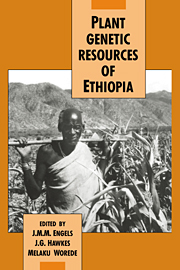Book contents
- Frontmatter
- Contents
- Contributors
- List of acronyms
- Preface
- Part I General introduction
- Part II The Ethiopian centre of diversity
- Part III Germplasm collection and conservation in Ethiopia
- Part IV Evaluation and utilization of Ethiopian genetic resources
- 18 Germplasm evaluation with special reference to the role of taxonomy in genebanks
- 19 Crop germplasm multiplication, characterization, evaluation and utilization at PGRC/E
- 20 Evaluation methods and utilization of germplasm of annual crop species
- 21 Evaluation and utilization of Ethiopian forage species
- 22 Improvement of indigenous durum wheat landraces in Ethiopia
- 23 Use of germplasm resources in breeding wheat for disease resistance
- 24 Indigenous barley germplasm in the Ethiopian breeding programme
- 25 The role of Ethiopian sorghum germplasm resources in the national breeding programme
- 26 Germplasm evaluation and breeding work on teff (Eragrostis tef) in Ethiopia
- 27 Pulse crops of Ethiopia: genetic resources and their utilization
- 28 Oil crop germplasm: a vital resource for the plant breeder
- 29 Significance of Ethiopian coffee genetic resources to coffee improvement
- 30 Use of Ethiopian germplasm in national and international programmes
- Index
24 - Indigenous barley germplasm in the Ethiopian breeding programme
Published online by Cambridge University Press: 30 October 2009
- Frontmatter
- Contents
- Contributors
- List of acronyms
- Preface
- Part I General introduction
- Part II The Ethiopian centre of diversity
- Part III Germplasm collection and conservation in Ethiopia
- Part IV Evaluation and utilization of Ethiopian genetic resources
- 18 Germplasm evaluation with special reference to the role of taxonomy in genebanks
- 19 Crop germplasm multiplication, characterization, evaluation and utilization at PGRC/E
- 20 Evaluation methods and utilization of germplasm of annual crop species
- 21 Evaluation and utilization of Ethiopian forage species
- 22 Improvement of indigenous durum wheat landraces in Ethiopia
- 23 Use of germplasm resources in breeding wheat for disease resistance
- 24 Indigenous barley germplasm in the Ethiopian breeding programme
- 25 The role of Ethiopian sorghum germplasm resources in the national breeding programme
- 26 Germplasm evaluation and breeding work on teff (Eragrostis tef) in Ethiopia
- 27 Pulse crops of Ethiopia: genetic resources and their utilization
- 28 Oil crop germplasm: a vital resource for the plant breeder
- 29 Significance of Ethiopian coffee genetic resources to coffee improvement
- 30 Use of Ethiopian germplasm in national and international programmes
- Index
Summary
Introduction
Barley in Ethiopia is used for human food, home-made beverages and beer. Its straw is used for animal feed and mattresses. It is produced in the highlands at altitudes ranging from 1800 to 3300 m above sea level, where poor soil fertility, frost, waterlogging and moderate soil acidity are major problems. It occupies an area of about 0.85 million hectares out of a total crop land of 6.0 million hectares with a productivity of about 1.2 t/ha (Central Statistics Office, 1984). At high altitudes it may be the only crop grown, with or without oats; and among the small grains it is the earliest to become available for consumption at the end of the rainy season.
Barley is grown in the main rainy season of June–September (‘meher’) on sloping and better drained clay soils. Some barley is grown in the short rainy season (‘belg’) on bottom lands in some regions. A few areas also grow barley from October to January (‘bega’), sometimes with supplementary irrigation. Double cropping is a common practice in the major barley growing regions: barley–barley in ‘belg’ and ‘meher’ seasons in Shewa, Welo, Arsi, and Bale; barley–barley in ‘meher’ and ‘bega’ in Gojam; and barley–pulses in Gondar.
The level of management is traditional. Farmers use their own landraces in most cases. Application of inorganic fertilizers and use of insecticides and herbicides are fairly low. The landraces are tolerant to marginal soil conditions.
- Type
- Chapter
- Information
- Plant Genetic Resources of Ethiopia , pp. 303 - 314Publisher: Cambridge University PressPrint publication year: 1991
- 1
- Cited by



